Analyzing Recruitment and Cultural Factors in Global HRM for M&S
VerifiedAdded on 2023/06/11
|9
|2619
|349
Report
AI Summary
This report examines International Human Resource Management (IHRM) with a focus on Marks and Spencer (M&S), a British multinational retailer. It outlines key approaches to recruitment strategies, including developing a clear employer brand, leveraging social media, creating reflective job posts, and considering college recruitment. Factors affecting the recruiting process, both internal (HR planning, organization size) and external (unemployment rate, competitors), are analyzed. A PESTLE analysis assesses the political, economic, social, technological, legal, and environmental factors influencing M&S's business. The report also explores how cultural factors impact business policies and procedures, including recruitment, selection, motivation, training, development, and compensation policies. The study concludes with recommendations for HR managers to adopt beneficial policies, update them regularly, use motivational strategies, offer suitable training, and ensure competitive compensation to foster a positive international working environment. Desklib offers similar solved assignments and study tools for students.
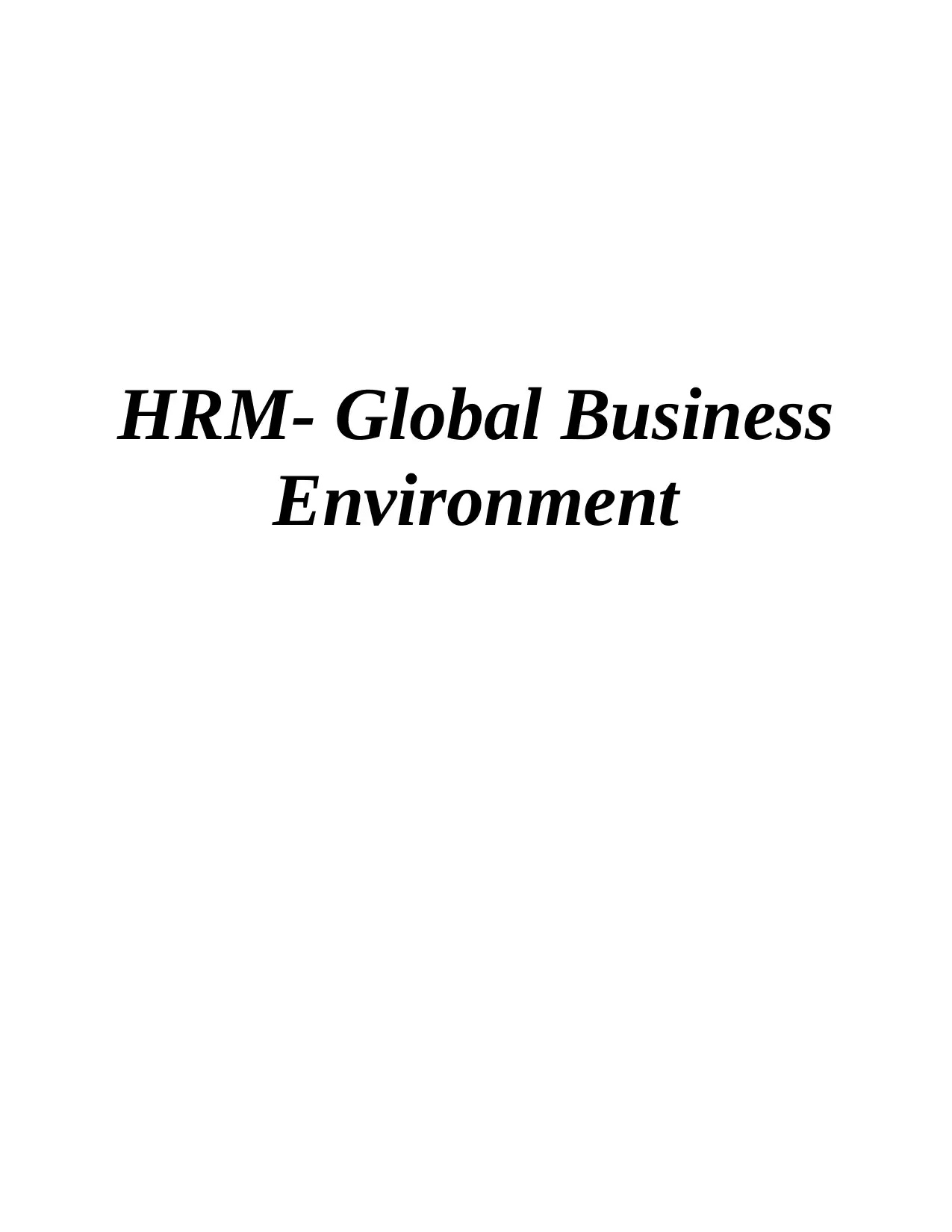
HRM- Global Business
Environment
Environment
Paraphrase This Document
Need a fresh take? Get an instant paraphrase of this document with our AI Paraphraser
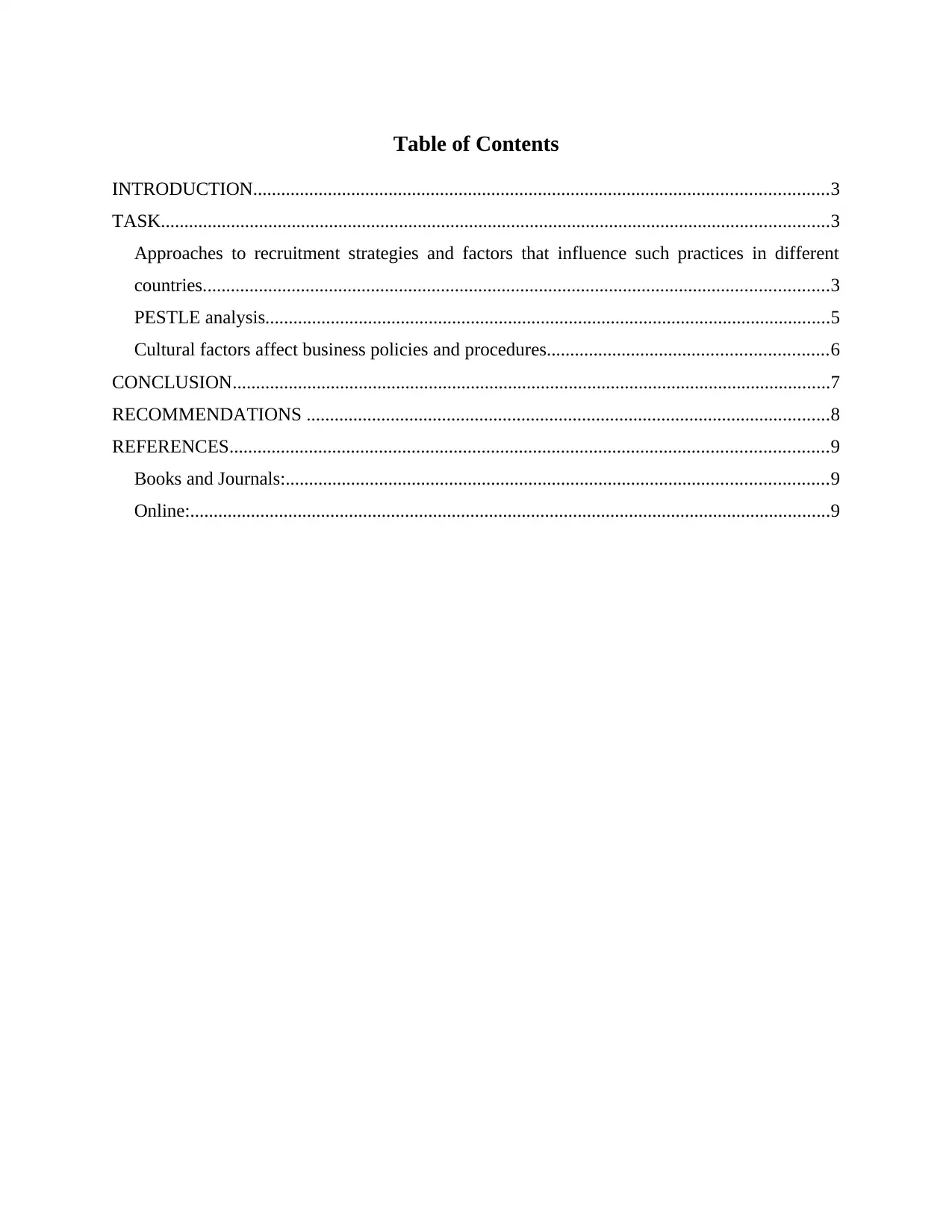
Table of Contents
INTRODUCTION...........................................................................................................................3
TASK...............................................................................................................................................3
Approaches to recruitment strategies and factors that influence such practices in different
countries......................................................................................................................................3
PESTLE analysis.........................................................................................................................5
Cultural factors affect business policies and procedures............................................................6
CONCLUSION................................................................................................................................7
RECOMMENDATIONS ................................................................................................................8
REFERENCES................................................................................................................................9
Books and Journals:....................................................................................................................9
Online:.........................................................................................................................................9
INTRODUCTION...........................................................................................................................3
TASK...............................................................................................................................................3
Approaches to recruitment strategies and factors that influence such practices in different
countries......................................................................................................................................3
PESTLE analysis.........................................................................................................................5
Cultural factors affect business policies and procedures............................................................6
CONCLUSION................................................................................................................................7
RECOMMENDATIONS ................................................................................................................8
REFERENCES................................................................................................................................9
Books and Journals:....................................................................................................................9
Online:.........................................................................................................................................9
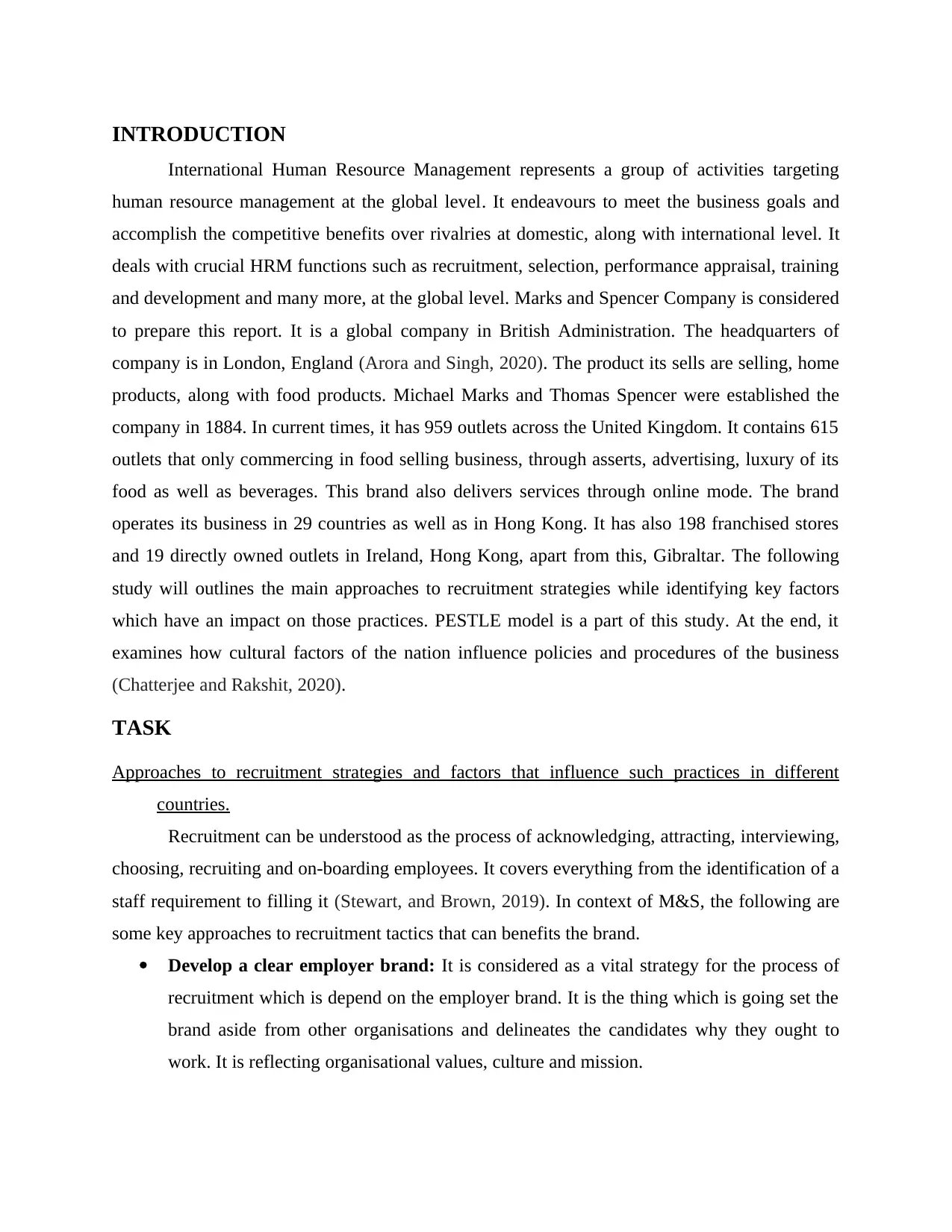
INTRODUCTION
International Human Resource Management represents a group of activities targeting
human resource management at the global level. It endeavours to meet the business goals and
accomplish the competitive benefits over rivalries at domestic, along with international level. It
deals with crucial HRM functions such as recruitment, selection, performance appraisal, training
and development and many more, at the global level. Marks and Spencer Company is considered
to prepare this report. It is a global company in British Administration. The headquarters of
company is in London, England (Arora and Singh, 2020). The product its sells are selling, home
products, along with food products. Michael Marks and Thomas Spencer were established the
company in 1884. In current times, it has 959 outlets across the United Kingdom. It contains 615
outlets that only commercing in food selling business, through asserts, advertising, luxury of its
food as well as beverages. This brand also delivers services through online mode. The brand
operates its business in 29 countries as well as in Hong Kong. It has also 198 franchised stores
and 19 directly owned outlets in Ireland, Hong Kong, apart from this, Gibraltar. The following
study will outlines the main approaches to recruitment strategies while identifying key factors
which have an impact on those practices. PESTLE model is a part of this study. At the end, it
examines how cultural factors of the nation influence policies and procedures of the business
(Chatterjee and Rakshit, 2020).
TASK
Approaches to recruitment strategies and factors that influence such practices in different
countries.
Recruitment can be understood as the process of acknowledging, attracting, interviewing,
choosing, recruiting and on-boarding employees. It covers everything from the identification of a
staff requirement to filling it (Stewart, and Brown, 2019). In context of M&S, the following are
some key approaches to recruitment tactics that can benefits the brand.
Develop a clear employer brand: It is considered as a vital strategy for the process of
recruitment which is depend on the employer brand. It is the thing which is going set the
brand aside from other organisations and delineates the candidates why they ought to
work. It is reflecting organisational values, culture and mission.
International Human Resource Management represents a group of activities targeting
human resource management at the global level. It endeavours to meet the business goals and
accomplish the competitive benefits over rivalries at domestic, along with international level. It
deals with crucial HRM functions such as recruitment, selection, performance appraisal, training
and development and many more, at the global level. Marks and Spencer Company is considered
to prepare this report. It is a global company in British Administration. The headquarters of
company is in London, England (Arora and Singh, 2020). The product its sells are selling, home
products, along with food products. Michael Marks and Thomas Spencer were established the
company in 1884. In current times, it has 959 outlets across the United Kingdom. It contains 615
outlets that only commercing in food selling business, through asserts, advertising, luxury of its
food as well as beverages. This brand also delivers services through online mode. The brand
operates its business in 29 countries as well as in Hong Kong. It has also 198 franchised stores
and 19 directly owned outlets in Ireland, Hong Kong, apart from this, Gibraltar. The following
study will outlines the main approaches to recruitment strategies while identifying key factors
which have an impact on those practices. PESTLE model is a part of this study. At the end, it
examines how cultural factors of the nation influence policies and procedures of the business
(Chatterjee and Rakshit, 2020).
TASK
Approaches to recruitment strategies and factors that influence such practices in different
countries.
Recruitment can be understood as the process of acknowledging, attracting, interviewing,
choosing, recruiting and on-boarding employees. It covers everything from the identification of a
staff requirement to filling it (Stewart, and Brown, 2019). In context of M&S, the following are
some key approaches to recruitment tactics that can benefits the brand.
Develop a clear employer brand: It is considered as a vital strategy for the process of
recruitment which is depend on the employer brand. It is the thing which is going set the
brand aside from other organisations and delineates the candidates why they ought to
work. It is reflecting organisational values, culture and mission.
⊘ This is a preview!⊘
Do you want full access?
Subscribe today to unlock all pages.

Trusted by 1+ million students worldwide
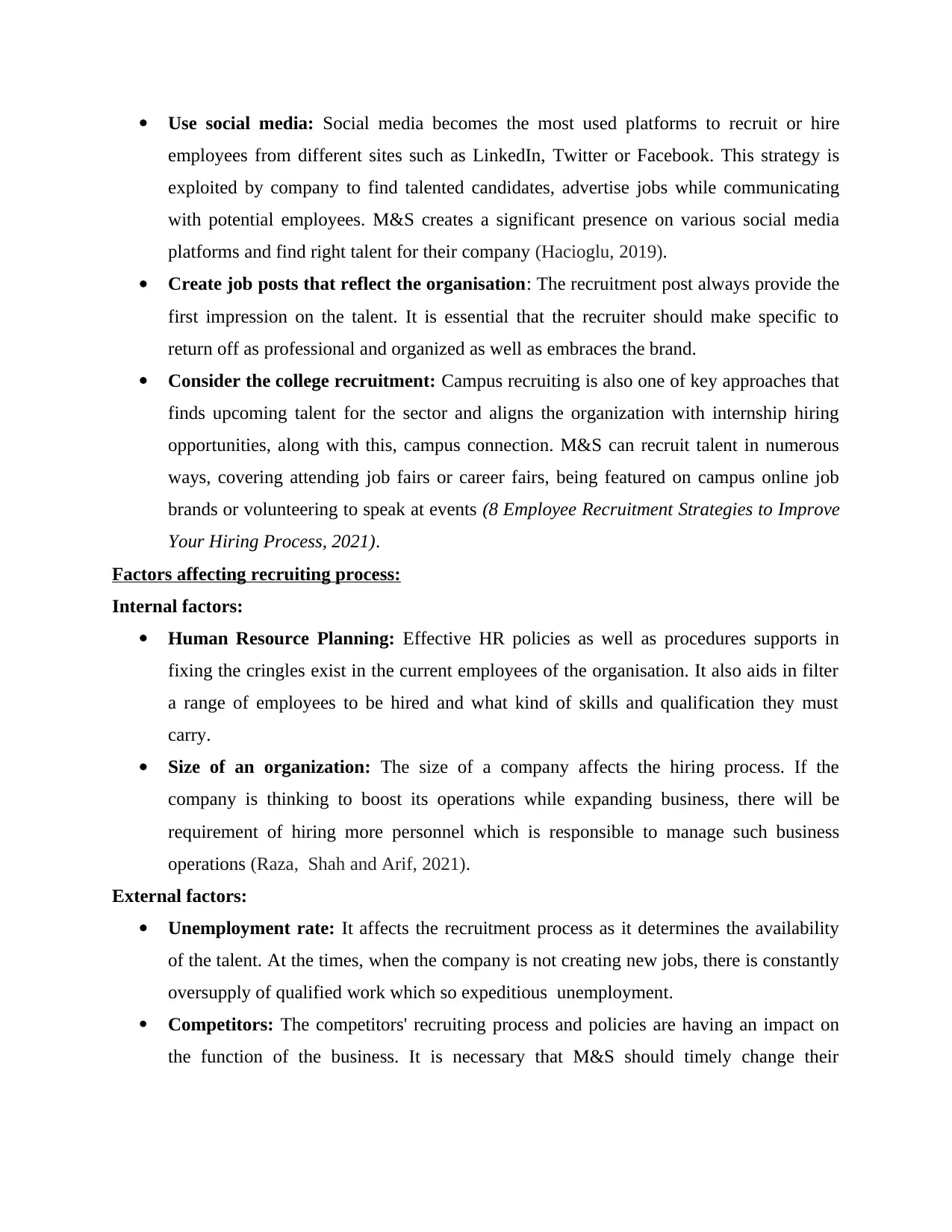
Use social media: Social media becomes the most used platforms to recruit or hire
employees from different sites such as LinkedIn, Twitter or Facebook. This strategy is
exploited by company to find talented candidates, advertise jobs while communicating
with potential employees. M&S creates a significant presence on various social media
platforms and find right talent for their company (Hacioglu, 2019).
Create job posts that reflect the organisation: The recruitment post always provide the
first impression on the talent. It is essential that the recruiter should make specific to
return off as professional and organized as well as embraces the brand.
Consider the college recruitment: Campus recruiting is also one of key approaches that
finds upcoming talent for the sector and aligns the organization with internship hiring
opportunities, along with this, campus connection. M&S can recruit talent in numerous
ways, covering attending job fairs or career fairs, being featured on campus online job
brands or volunteering to speak at events (8 Employee Recruitment Strategies to Improve
Your Hiring Process, 2021).
Factors affecting recruiting process:
Internal factors:
Human Resource Planning: Effective HR policies as well as procedures supports in
fixing the cringles exist in the current employees of the organisation. It also aids in filter
a range of employees to be hired and what kind of skills and qualification they must
carry.
Size of an organization: The size of a company affects the hiring process. If the
company is thinking to boost its operations while expanding business, there will be
requirement of hiring more personnel which is responsible to manage such business
operations (Raza, Shah and Arif, 2021).
External factors:
Unemployment rate: It affects the recruitment process as it determines the availability
of the talent. At the times, when the company is not creating new jobs, there is constantly
oversupply of qualified work which so expeditious unemployment.
Competitors: The competitors' recruiting process and policies are having an impact on
the function of the business. It is necessary that M&S should timely change their
employees from different sites such as LinkedIn, Twitter or Facebook. This strategy is
exploited by company to find talented candidates, advertise jobs while communicating
with potential employees. M&S creates a significant presence on various social media
platforms and find right talent for their company (Hacioglu, 2019).
Create job posts that reflect the organisation: The recruitment post always provide the
first impression on the talent. It is essential that the recruiter should make specific to
return off as professional and organized as well as embraces the brand.
Consider the college recruitment: Campus recruiting is also one of key approaches that
finds upcoming talent for the sector and aligns the organization with internship hiring
opportunities, along with this, campus connection. M&S can recruit talent in numerous
ways, covering attending job fairs or career fairs, being featured on campus online job
brands or volunteering to speak at events (8 Employee Recruitment Strategies to Improve
Your Hiring Process, 2021).
Factors affecting recruiting process:
Internal factors:
Human Resource Planning: Effective HR policies as well as procedures supports in
fixing the cringles exist in the current employees of the organisation. It also aids in filter
a range of employees to be hired and what kind of skills and qualification they must
carry.
Size of an organization: The size of a company affects the hiring process. If the
company is thinking to boost its operations while expanding business, there will be
requirement of hiring more personnel which is responsible to manage such business
operations (Raza, Shah and Arif, 2021).
External factors:
Unemployment rate: It affects the recruitment process as it determines the availability
of the talent. At the times, when the company is not creating new jobs, there is constantly
oversupply of qualified work which so expeditious unemployment.
Competitors: The competitors' recruiting process and policies are having an impact on
the function of the business. It is necessary that M&S should timely change their
Paraphrase This Document
Need a fresh take? Get an instant paraphrase of this document with our AI Paraphraser
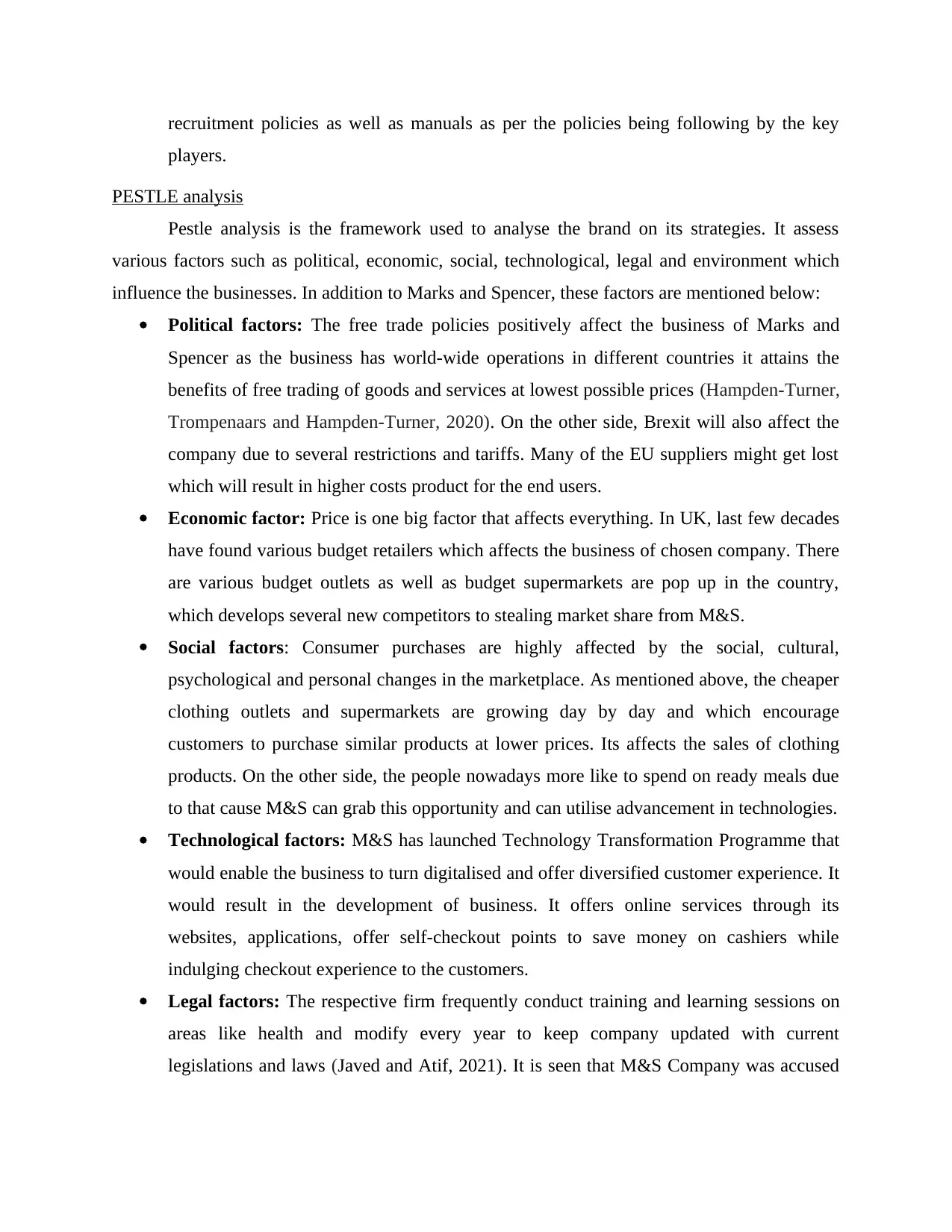
recruitment policies as well as manuals as per the policies being following by the key
players.
PESTLE analysis
Pestle analysis is the framework used to analyse the brand on its strategies. It assess
various factors such as political, economic, social, technological, legal and environment which
influence the businesses. In addition to Marks and Spencer, these factors are mentioned below:
Political factors: The free trade policies positively affect the business of Marks and
Spencer as the business has world-wide operations in different countries it attains the
benefits of free trading of goods and services at lowest possible prices (Hampden-Turner,
Trompenaars and Hampden-Turner, 2020). On the other side, Brexit will also affect the
company due to several restrictions and tariffs. Many of the EU suppliers might get lost
which will result in higher costs product for the end users.
Economic factor: Price is one big factor that affects everything. In UK, last few decades
have found various budget retailers which affects the business of chosen company. There
are various budget outlets as well as budget supermarkets are pop up in the country,
which develops several new competitors to stealing market share from M&S.
Social factors: Consumer purchases are highly affected by the social, cultural,
psychological and personal changes in the marketplace. As mentioned above, the cheaper
clothing outlets and supermarkets are growing day by day and which encourage
customers to purchase similar products at lower prices. Its affects the sales of clothing
products. On the other side, the people nowadays more like to spend on ready meals due
to that cause M&S can grab this opportunity and can utilise advancement in technologies.
Technological factors: M&S has launched Technology Transformation Programme that
would enable the business to turn digitalised and offer diversified customer experience. It
would result in the development of business. It offers online services through its
websites, applications, offer self-checkout points to save money on cashiers while
indulging checkout experience to the customers.
Legal factors: The respective firm frequently conduct training and learning sessions on
areas like health and modify every year to keep company updated with current
legislations and laws (Javed and Atif, 2021). It is seen that M&S Company was accused
players.
PESTLE analysis
Pestle analysis is the framework used to analyse the brand on its strategies. It assess
various factors such as political, economic, social, technological, legal and environment which
influence the businesses. In addition to Marks and Spencer, these factors are mentioned below:
Political factors: The free trade policies positively affect the business of Marks and
Spencer as the business has world-wide operations in different countries it attains the
benefits of free trading of goods and services at lowest possible prices (Hampden-Turner,
Trompenaars and Hampden-Turner, 2020). On the other side, Brexit will also affect the
company due to several restrictions and tariffs. Many of the EU suppliers might get lost
which will result in higher costs product for the end users.
Economic factor: Price is one big factor that affects everything. In UK, last few decades
have found various budget retailers which affects the business of chosen company. There
are various budget outlets as well as budget supermarkets are pop up in the country,
which develops several new competitors to stealing market share from M&S.
Social factors: Consumer purchases are highly affected by the social, cultural,
psychological and personal changes in the marketplace. As mentioned above, the cheaper
clothing outlets and supermarkets are growing day by day and which encourage
customers to purchase similar products at lower prices. Its affects the sales of clothing
products. On the other side, the people nowadays more like to spend on ready meals due
to that cause M&S can grab this opportunity and can utilise advancement in technologies.
Technological factors: M&S has launched Technology Transformation Programme that
would enable the business to turn digitalised and offer diversified customer experience. It
would result in the development of business. It offers online services through its
websites, applications, offer self-checkout points to save money on cashiers while
indulging checkout experience to the customers.
Legal factors: The respective firm frequently conduct training and learning sessions on
areas like health and modify every year to keep company updated with current
legislations and laws (Javed and Atif, 2021). It is seen that M&S Company was accused
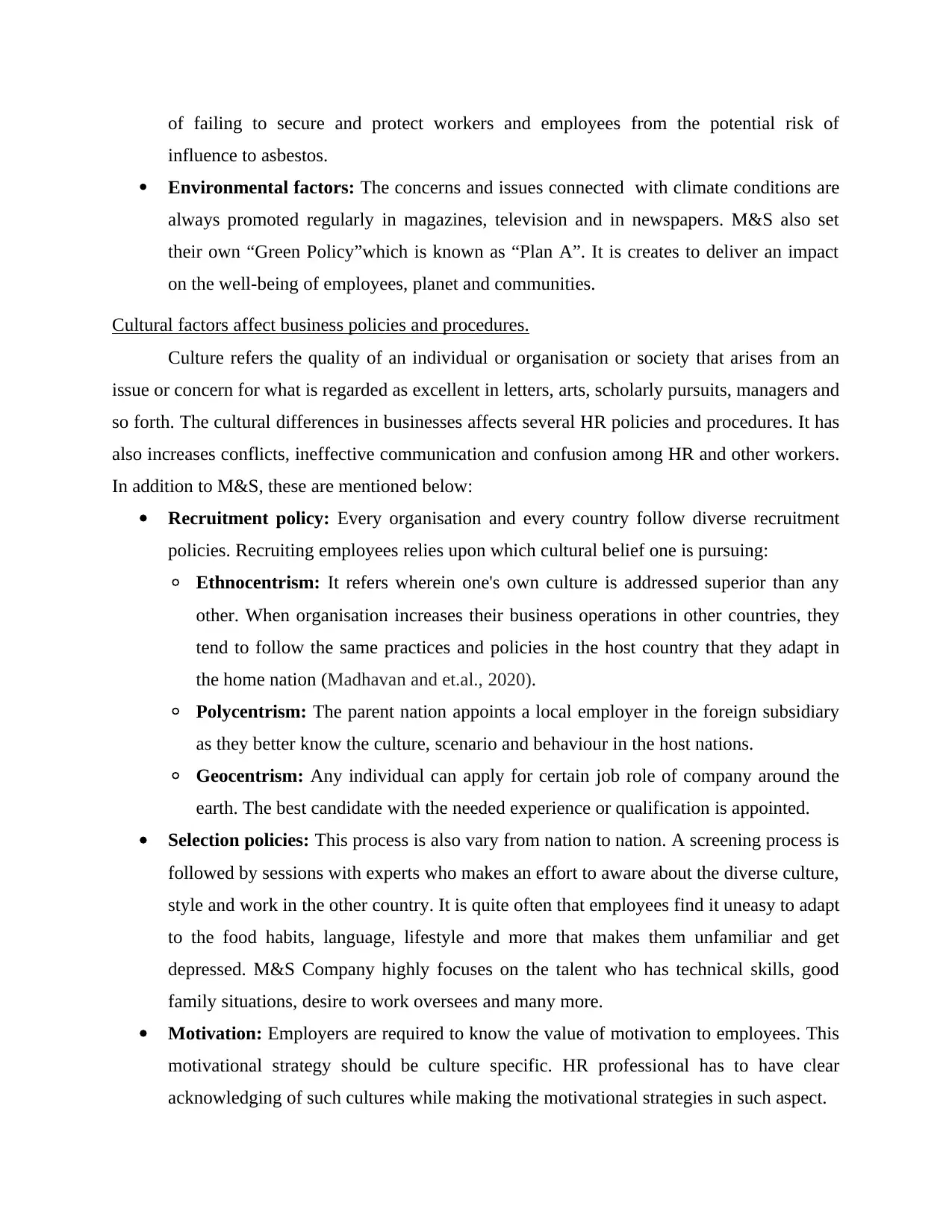
of failing to secure and protect workers and employees from the potential risk of
influence to asbestos.
Environmental factors: The concerns and issues connected with climate conditions are
always promoted regularly in magazines, television and in newspapers. M&S also set
their own “Green Policy”which is known as “Plan A”. It is creates to deliver an impact
on the well-being of employees, planet and communities.
Cultural factors affect business policies and procedures.
Culture refers the quality of an individual or organisation or society that arises from an
issue or concern for what is regarded as excellent in letters, arts, scholarly pursuits, managers and
so forth. The cultural differences in businesses affects several HR policies and procedures. It has
also increases conflicts, ineffective communication and confusion among HR and other workers.
In addition to M&S, these are mentioned below:
Recruitment policy: Every organisation and every country follow diverse recruitment
policies. Recruiting employees relies upon which cultural belief one is pursuing:
◦ Ethnocentrism: It refers wherein one's own culture is addressed superior than any
other. When organisation increases their business operations in other countries, they
tend to follow the same practices and policies in the host country that they adapt in
the home nation (Madhavan and et.al., 2020).
◦ Polycentrism: The parent nation appoints a local employer in the foreign subsidiary
as they better know the culture, scenario and behaviour in the host nations.
◦ Geocentrism: Any individual can apply for certain job role of company around the
earth. The best candidate with the needed experience or qualification is appointed.
Selection policies: This process is also vary from nation to nation. A screening process is
followed by sessions with experts who makes an effort to aware about the diverse culture,
style and work in the other country. It is quite often that employees find it uneasy to adapt
to the food habits, language, lifestyle and more that makes them unfamiliar and get
depressed. M&S Company highly focuses on the talent who has technical skills, good
family situations, desire to work oversees and many more.
Motivation: Employers are required to know the value of motivation to employees. This
motivational strategy should be culture specific. HR professional has to have clear
acknowledging of such cultures while making the motivational strategies in such aspect.
influence to asbestos.
Environmental factors: The concerns and issues connected with climate conditions are
always promoted regularly in magazines, television and in newspapers. M&S also set
their own “Green Policy”which is known as “Plan A”. It is creates to deliver an impact
on the well-being of employees, planet and communities.
Cultural factors affect business policies and procedures.
Culture refers the quality of an individual or organisation or society that arises from an
issue or concern for what is regarded as excellent in letters, arts, scholarly pursuits, managers and
so forth. The cultural differences in businesses affects several HR policies and procedures. It has
also increases conflicts, ineffective communication and confusion among HR and other workers.
In addition to M&S, these are mentioned below:
Recruitment policy: Every organisation and every country follow diverse recruitment
policies. Recruiting employees relies upon which cultural belief one is pursuing:
◦ Ethnocentrism: It refers wherein one's own culture is addressed superior than any
other. When organisation increases their business operations in other countries, they
tend to follow the same practices and policies in the host country that they adapt in
the home nation (Madhavan and et.al., 2020).
◦ Polycentrism: The parent nation appoints a local employer in the foreign subsidiary
as they better know the culture, scenario and behaviour in the host nations.
◦ Geocentrism: Any individual can apply for certain job role of company around the
earth. The best candidate with the needed experience or qualification is appointed.
Selection policies: This process is also vary from nation to nation. A screening process is
followed by sessions with experts who makes an effort to aware about the diverse culture,
style and work in the other country. It is quite often that employees find it uneasy to adapt
to the food habits, language, lifestyle and more that makes them unfamiliar and get
depressed. M&S Company highly focuses on the talent who has technical skills, good
family situations, desire to work oversees and many more.
Motivation: Employers are required to know the value of motivation to employees. This
motivational strategy should be culture specific. HR professional has to have clear
acknowledging of such cultures while making the motivational strategies in such aspect.
⊘ This is a preview!⊘
Do you want full access?
Subscribe today to unlock all pages.

Trusted by 1+ million students worldwide
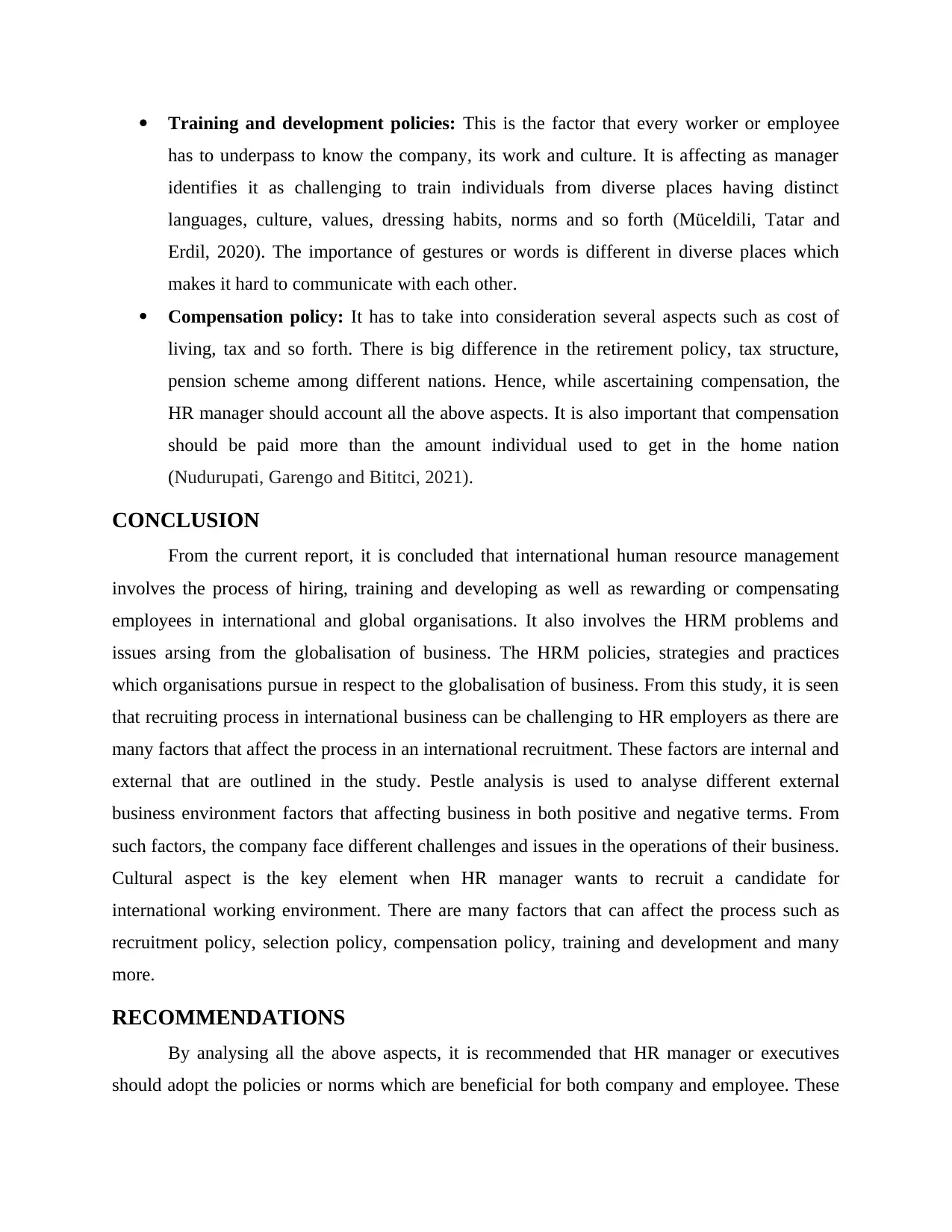
Training and development policies: This is the factor that every worker or employee
has to underpass to know the company, its work and culture. It is affecting as manager
identifies it as challenging to train individuals from diverse places having distinct
languages, culture, values, dressing habits, norms and so forth (Müceldili, Tatar and
Erdil, 2020). The importance of gestures or words is different in diverse places which
makes it hard to communicate with each other.
Compensation policy: It has to take into consideration several aspects such as cost of
living, tax and so forth. There is big difference in the retirement policy, tax structure,
pension scheme among different nations. Hence, while ascertaining compensation, the
HR manager should account all the above aspects. It is also important that compensation
should be paid more than the amount individual used to get in the home nation
(Nudurupati, Garengo and Bititci, 2021).
CONCLUSION
From the current report, it is concluded that international human resource management
involves the process of hiring, training and developing as well as rewarding or compensating
employees in international and global organisations. It also involves the HRM problems and
issues arsing from the globalisation of business. The HRM policies, strategies and practices
which organisations pursue in respect to the globalisation of business. From this study, it is seen
that recruiting process in international business can be challenging to HR employers as there are
many factors that affect the process in an international recruitment. These factors are internal and
external that are outlined in the study. Pestle analysis is used to analyse different external
business environment factors that affecting business in both positive and negative terms. From
such factors, the company face different challenges and issues in the operations of their business.
Cultural aspect is the key element when HR manager wants to recruit a candidate for
international working environment. There are many factors that can affect the process such as
recruitment policy, selection policy, compensation policy, training and development and many
more.
RECOMMENDATIONS
By analysing all the above aspects, it is recommended that HR manager or executives
should adopt the policies or norms which are beneficial for both company and employee. These
has to underpass to know the company, its work and culture. It is affecting as manager
identifies it as challenging to train individuals from diverse places having distinct
languages, culture, values, dressing habits, norms and so forth (Müceldili, Tatar and
Erdil, 2020). The importance of gestures or words is different in diverse places which
makes it hard to communicate with each other.
Compensation policy: It has to take into consideration several aspects such as cost of
living, tax and so forth. There is big difference in the retirement policy, tax structure,
pension scheme among different nations. Hence, while ascertaining compensation, the
HR manager should account all the above aspects. It is also important that compensation
should be paid more than the amount individual used to get in the home nation
(Nudurupati, Garengo and Bititci, 2021).
CONCLUSION
From the current report, it is concluded that international human resource management
involves the process of hiring, training and developing as well as rewarding or compensating
employees in international and global organisations. It also involves the HRM problems and
issues arsing from the globalisation of business. The HRM policies, strategies and practices
which organisations pursue in respect to the globalisation of business. From this study, it is seen
that recruiting process in international business can be challenging to HR employers as there are
many factors that affect the process in an international recruitment. These factors are internal and
external that are outlined in the study. Pestle analysis is used to analyse different external
business environment factors that affecting business in both positive and negative terms. From
such factors, the company face different challenges and issues in the operations of their business.
Cultural aspect is the key element when HR manager wants to recruit a candidate for
international working environment. There are many factors that can affect the process such as
recruitment policy, selection policy, compensation policy, training and development and many
more.
RECOMMENDATIONS
By analysing all the above aspects, it is recommended that HR manager or executives
should adopt the policies or norms which are beneficial for both company and employee. These
Paraphrase This Document
Need a fresh take? Get an instant paraphrase of this document with our AI Paraphraser
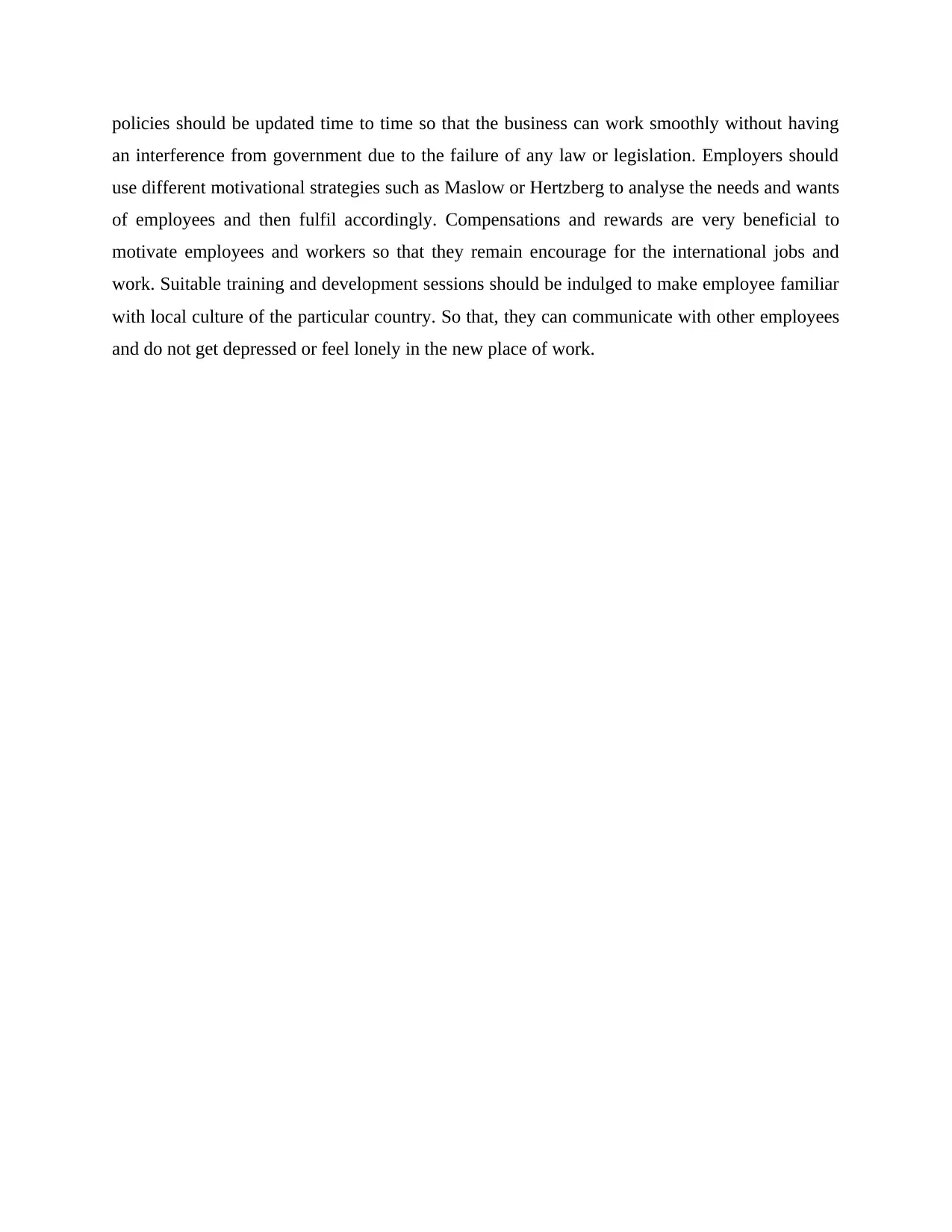
policies should be updated time to time so that the business can work smoothly without having
an interference from government due to the failure of any law or legislation. Employers should
use different motivational strategies such as Maslow or Hertzberg to analyse the needs and wants
of employees and then fulfil accordingly. Compensations and rewards are very beneficial to
motivate employees and workers so that they remain encourage for the international jobs and
work. Suitable training and development sessions should be indulged to make employee familiar
with local culture of the particular country. So that, they can communicate with other employees
and do not get depressed or feel lonely in the new place of work.
an interference from government due to the failure of any law or legislation. Employers should
use different motivational strategies such as Maslow or Hertzberg to analyse the needs and wants
of employees and then fulfil accordingly. Compensations and rewards are very beneficial to
motivate employees and workers so that they remain encourage for the international jobs and
work. Suitable training and development sessions should be indulged to make employee familiar
with local culture of the particular country. So that, they can communicate with other employees
and do not get depressed or feel lonely in the new place of work.
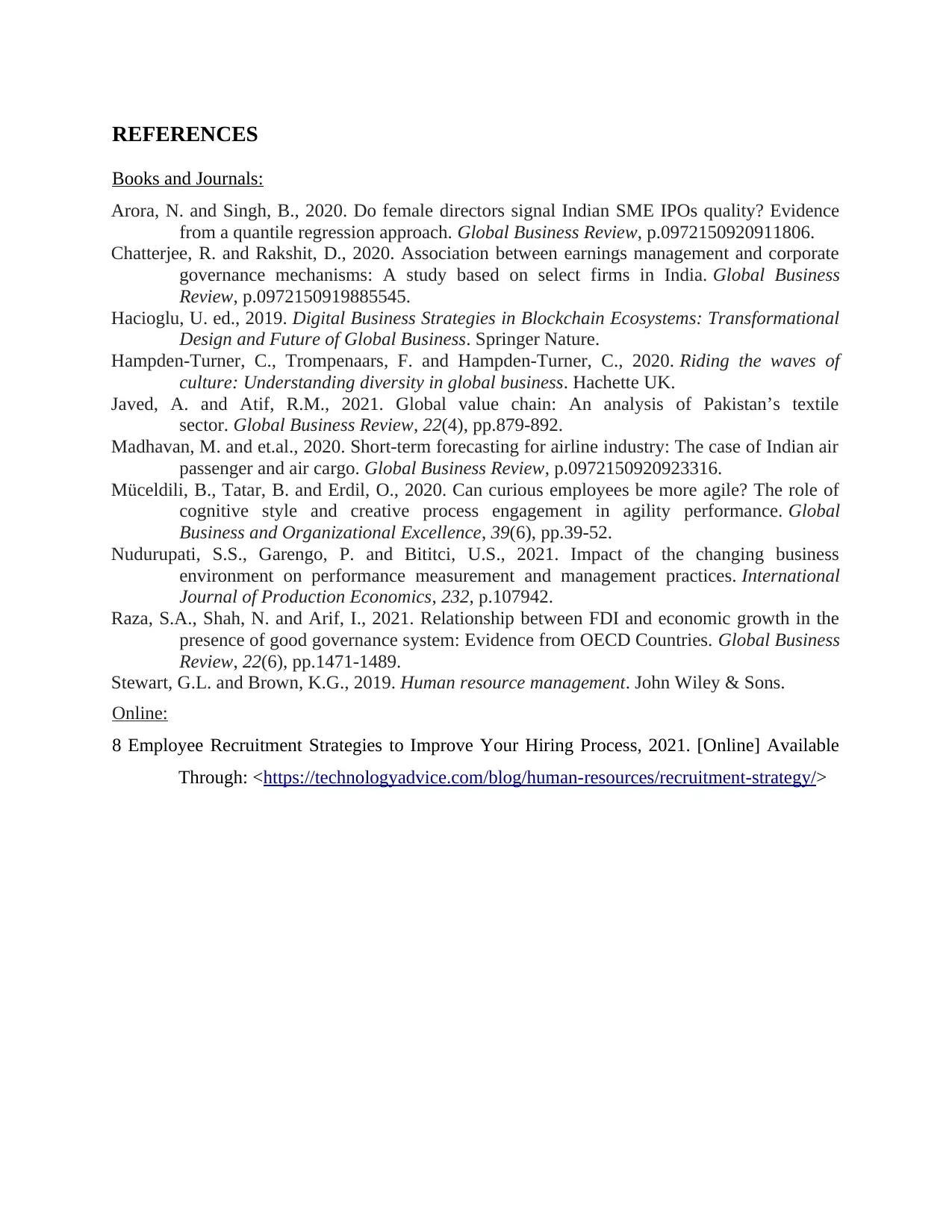
REFERENCES
Books and Journals:
Arora, N. and Singh, B., 2020. Do female directors signal Indian SME IPOs quality? Evidence
from a quantile regression approach. Global Business Review, p.0972150920911806.
Chatterjee, R. and Rakshit, D., 2020. Association between earnings management and corporate
governance mechanisms: A study based on select firms in India. Global Business
Review, p.0972150919885545.
Hacioglu, U. ed., 2019. Digital Business Strategies in Blockchain Ecosystems: Transformational
Design and Future of Global Business. Springer Nature.
Hampden-Turner, C., Trompenaars, F. and Hampden-Turner, C., 2020. Riding the waves of
culture: Understanding diversity in global business. Hachette UK.
Javed, A. and Atif, R.M., 2021. Global value chain: An analysis of Pakistan’s textile
sector. Global Business Review, 22(4), pp.879-892.
Madhavan, M. and et.al., 2020. Short-term forecasting for airline industry: The case of Indian air
passenger and air cargo. Global Business Review, p.0972150920923316.
Müceldili, B., Tatar, B. and Erdil, O., 2020. Can curious employees be more agile? The role of
cognitive style and creative process engagement in agility performance. Global
Business and Organizational Excellence, 39(6), pp.39-52.
Nudurupati, S.S., Garengo, P. and Bititci, U.S., 2021. Impact of the changing business
environment on performance measurement and management practices. International
Journal of Production Economics, 232, p.107942.
Raza, S.A., Shah, N. and Arif, I., 2021. Relationship between FDI and economic growth in the
presence of good governance system: Evidence from OECD Countries. Global Business
Review, 22(6), pp.1471-1489.
Stewart, G.L. and Brown, K.G., 2019. Human resource management. John Wiley & Sons.
Online:
8 Employee Recruitment Strategies to Improve Your Hiring Process, 2021. [Online] Available
Through: <https://technologyadvice.com/blog/human-resources/recruitment-strategy/>
Books and Journals:
Arora, N. and Singh, B., 2020. Do female directors signal Indian SME IPOs quality? Evidence
from a quantile regression approach. Global Business Review, p.0972150920911806.
Chatterjee, R. and Rakshit, D., 2020. Association between earnings management and corporate
governance mechanisms: A study based on select firms in India. Global Business
Review, p.0972150919885545.
Hacioglu, U. ed., 2019. Digital Business Strategies in Blockchain Ecosystems: Transformational
Design and Future of Global Business. Springer Nature.
Hampden-Turner, C., Trompenaars, F. and Hampden-Turner, C., 2020. Riding the waves of
culture: Understanding diversity in global business. Hachette UK.
Javed, A. and Atif, R.M., 2021. Global value chain: An analysis of Pakistan’s textile
sector. Global Business Review, 22(4), pp.879-892.
Madhavan, M. and et.al., 2020. Short-term forecasting for airline industry: The case of Indian air
passenger and air cargo. Global Business Review, p.0972150920923316.
Müceldili, B., Tatar, B. and Erdil, O., 2020. Can curious employees be more agile? The role of
cognitive style and creative process engagement in agility performance. Global
Business and Organizational Excellence, 39(6), pp.39-52.
Nudurupati, S.S., Garengo, P. and Bititci, U.S., 2021. Impact of the changing business
environment on performance measurement and management practices. International
Journal of Production Economics, 232, p.107942.
Raza, S.A., Shah, N. and Arif, I., 2021. Relationship between FDI and economic growth in the
presence of good governance system: Evidence from OECD Countries. Global Business
Review, 22(6), pp.1471-1489.
Stewart, G.L. and Brown, K.G., 2019. Human resource management. John Wiley & Sons.
Online:
8 Employee Recruitment Strategies to Improve Your Hiring Process, 2021. [Online] Available
Through: <https://technologyadvice.com/blog/human-resources/recruitment-strategy/>
⊘ This is a preview!⊘
Do you want full access?
Subscribe today to unlock all pages.

Trusted by 1+ million students worldwide
1 out of 9
Related Documents
Your All-in-One AI-Powered Toolkit for Academic Success.
+13062052269
info@desklib.com
Available 24*7 on WhatsApp / Email
![[object Object]](/_next/static/media/star-bottom.7253800d.svg)
Unlock your academic potential
Copyright © 2020–2025 A2Z Services. All Rights Reserved. Developed and managed by ZUCOL.





